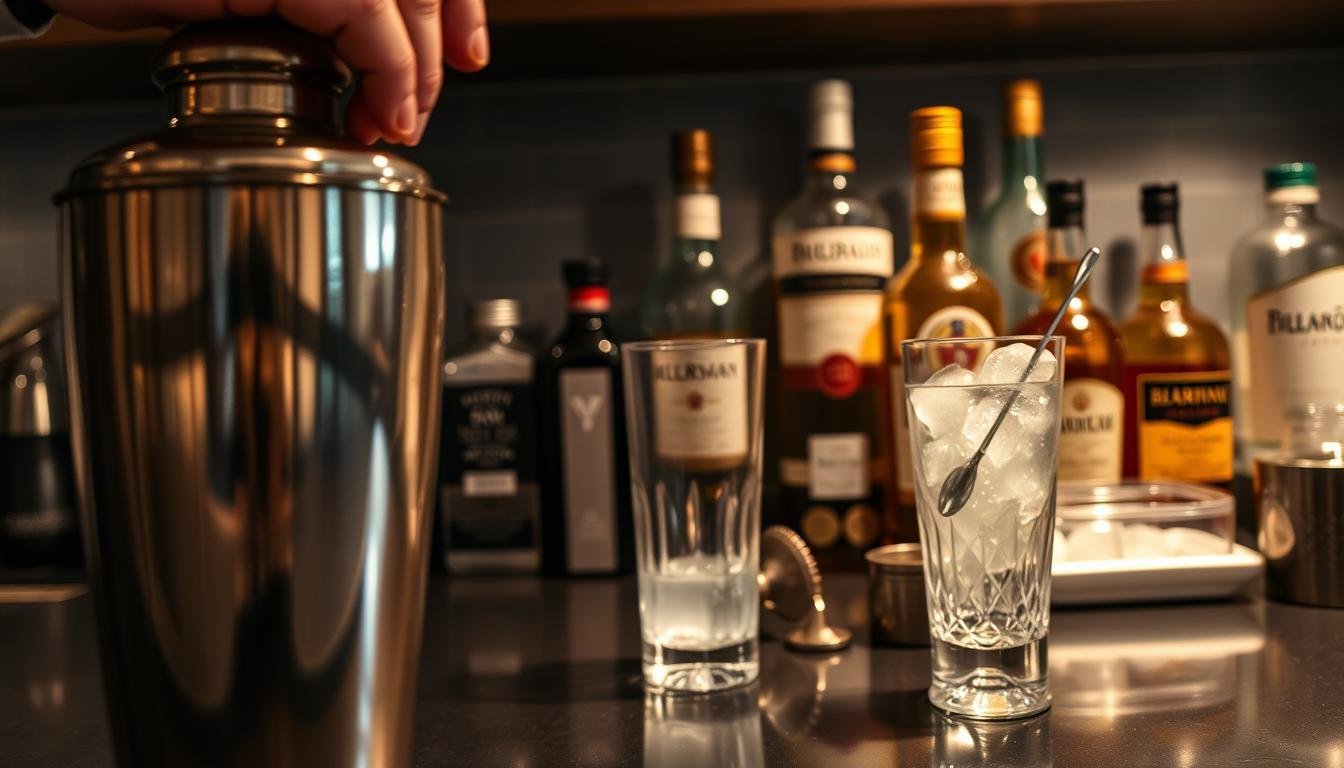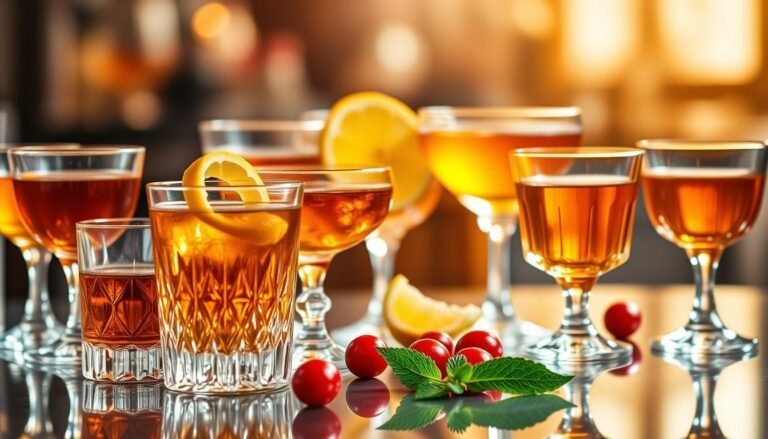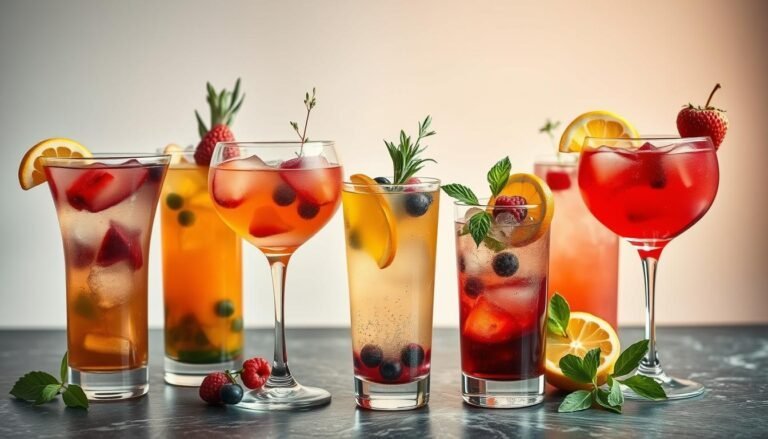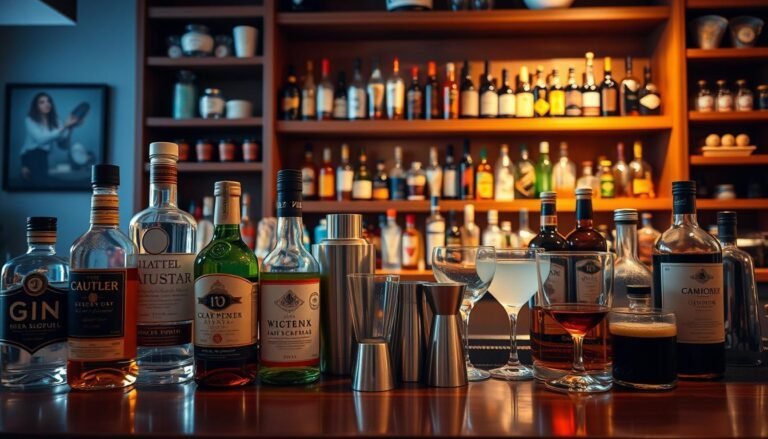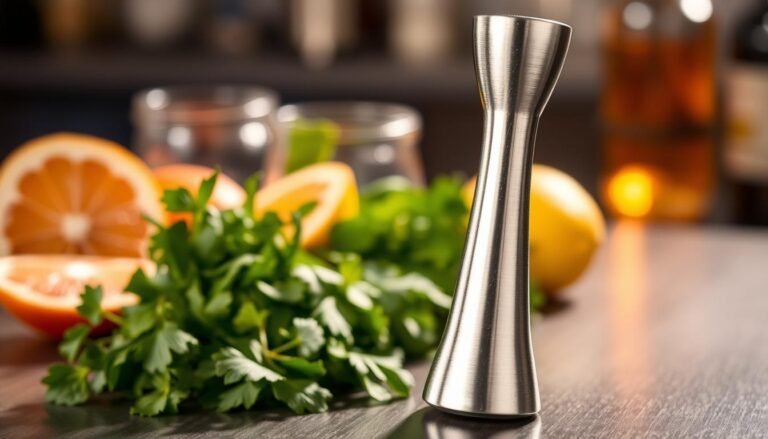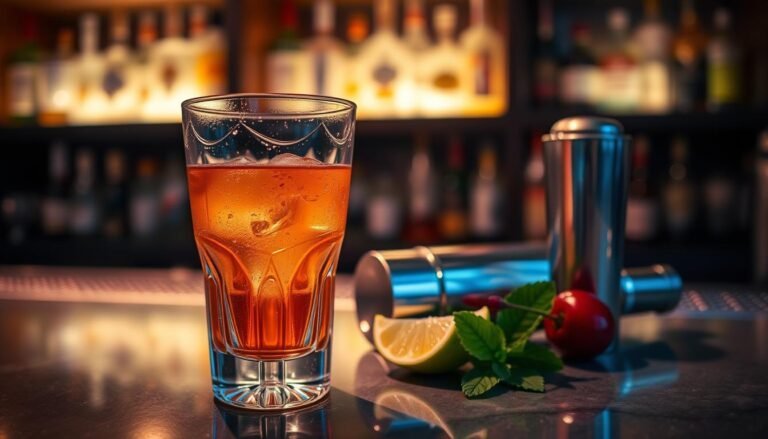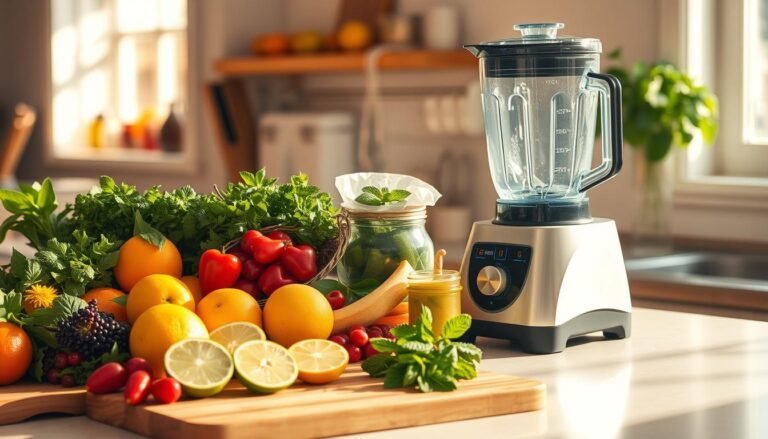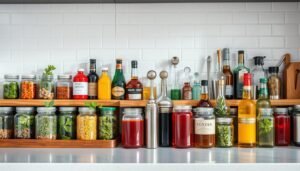Disclosure: This Post Contains Affiliate Links; We earn a commission on purchases.
Making the perfect cocktail is more than just mixing ingredients. It’s about knowing mixing techniques well. Shaking, stirring, and muddling are key to making great cocktails.
If you want to get better at mixing drinks, learning these basics is key. Essential cocktail techniques like shaking, stirring, and muddling are vital. They help make all sorts of cocktails, from old favorites to new ones.
Key Takeaways
- Mastering mixing techniques is key to making top-notch cocktails.
- Shaking is best for cocktails with different ingredients, like dairy or egg.
- Stirring works well for cocktails that focus on spirits.
- Muddling helps get flavors from herbs and fruits.
- Using the right tools, like shakers and muddlers, is important for each method.
The Art and Science of Mixology
Mixology is an art that needs precision, creativity, and a deep science understanding. The techniques used in mixing drinks greatly affect the taste, texture, and quality of the final product.
Why Technique Matters in Cocktail Making
The technique in cocktail making is key. It shapes the drink’s flavor, clarity, and temperature. Different cocktail mixing methods, like shaking, stirring, or muddling, are used to get the right result. Shaking adds dilution and makes the drink airy. Stirring, on the other hand, chills and dilutes without air.
Essential Tools for Proper Drink Mixing
Having the right tools is key to mastering the best way to mix drinks. Bartenders use shakers, strainers, jiggers, and muddlers to make cocktails. For those wanting to improve their home bar, https://quicksimpledrinks.com/recommended-products/ offers insights into bartender techniques for mixing drinks and the tools needed. A good shaker is essential for mixing and chilling ingredients well.
Mastering the Shake: A Complete Guide
Shaking cocktails is both a science and an art. Bartenders use it to mix, chill, and aerate ingredients. This creates a perfect balance of flavors and textures. Knowing when and how to shake is key to making great cocktails.
When to Shake a Cocktail
Not every cocktail needs shaking. But, it’s vital for many. Cocktails with citrus, dairy, or egg whites need shaking to mix well.
Cocktails with Citrus, Dairy, or Egg Whites
Drinks like the Pisco Sour or Whiskey Sour get better with shaking. This mixes citrus juice with other ingredients. Cocktails with dairy or egg whites, like a Classic Ramos Gin Fizz, need shaking for a smooth texture.
How Shaking Affects Texture and Dilution
Shaking not only cools the ingredients but also dilutes the drink. It can also add air, changing the texture. The shake’s length and strength greatly impact the final drink.
Proper Shaking Technique
Getting the perfect shake is more than just force; it’s about technique. A dry shake (without ice first) followed by a wet shake (with ice) is used for cocktails with egg whites or cream. This mixes ingredients well.
Dry Shake vs. Wet Shake Methods
The dry shake froths egg whites or mixes thick ingredients. Then, a wet shake chills and dilutes the cocktail.
Achieving the Perfect Chill and Aeration
The goal of shaking is to chill and aerate the cocktail. Finding the right balance between chilling and dilution is essential for a great drink.
Common Shaking Mistakes to Avoid
Common mistakes include over-dilution, inadequate chilling, and poor texture. Practicing and knowing the cocktail’s makeup can help avoid these problems.
- Use the right type and amount of ice.
- Shake with enough vigor but avoid over-shaking.
- Strain the cocktail properly to maintain clarity and texture.
The Subtle Art of Stirring Drinks
In mixology, stirring is a precise skill. It needs patience and a deep understanding of the ingredients. This method is key for cocktails that need a gentle touch to keep their flavor and clarity.
Cocktails That Should Be Stirred, Not Shaken
Not all cocktails are the same. Some are better stirred than shaken. This is true for spirit-forward cocktails.
Spirit-Forward Cocktails
Spirit-forward cocktails are best stirred. This keeps the drink clear and lets the spirit’s flavors stand out. Classics like the Negroni and the Manhattan are great examples.
Preserving Clarity and Mouthfeel
Stirring is gentler than shaking. It’s perfect for cocktails that want clarity and a smooth feel. Stirring makes the drink silky without adding air or water.
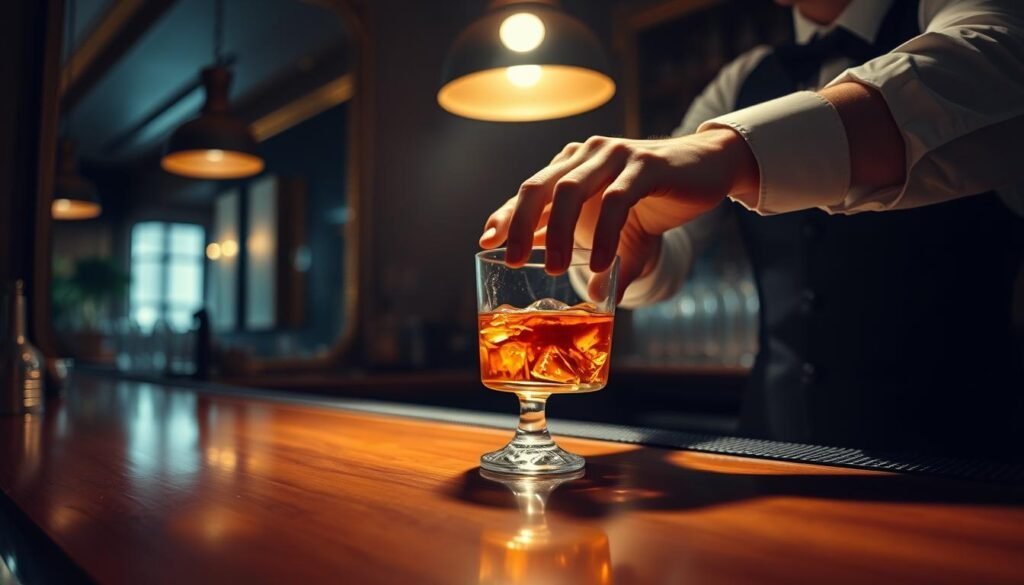
Step-by-Step Stirring Method
To stir a cocktail well, you need to know how to use a bar spoon.
Bar Spoon Techniques
The bar spoon is key for stirring. Hold the spoon in the mixing glass and rotate it gently. This moves the liquid smoothly and chills the cocktail evenly.
Timing and Rhythm
Timing and rhythm in stirring are important. Stir for 30 seconds to a minute, depending on the cocktail. The goal is to chill and dilute without overdoing it.
Achieving the Perfect Dilution and Temperature
Getting the perfect dilution and temperature is vital. Stirring lets bartenders control dilution by adjusting time. The ideal temperature is just below freezing, which keeps flavors and textures sharp.
Mastering stirring can make a bartender’s skills shine. Knowing how to stir is a basic skill for any bartender wanting to improve.
- Use a bar spoon to stir cocktails gently.
- Stir for 30 seconds to a minute, depending on the cocktail.
- Adjust stirring time to achieve the perfect dilution.
With practice and patience, anyone can get better at mixing drinks. This shows skill and attention to detail in every cocktail.
Guide to Mixing Drinks: Shaking, Stirring, and Muddling Techniques
Muddling is a simple yet effective way to bring out the best in fresh ingredients for cocktails. Bartenders use it to release essential oils and flavors. This makes the drink taste better.
Muddling: Extracting Flavors from Fresh Ingredients
Muddling uses a tool to press or crush ingredients in a cocktail shaker or mixing glass. It’s great for releasing flavors and oils from herbs, fruits, and spices.
Gentle vs. Vigorous Muddling
The intensity of muddling depends on the ingredient. Gentle muddling is good for delicate herbs like mint or basil. It releases their flavors without damage. Vigorous muddling is needed for harder ingredients like citrus fruits or spices to get their flavors out.
Herbs, Fruits, and Spices: What Needs What
Different ingredients need different muddling techniques. For example, herbs like mint are best muddled gently to avoid bruising. Citrus fruits may need a bit more force to release their juices and oils. Knowing the right technique for each ingredient is key to getting the right flavor in a cocktail.
Different Muddling Styles for Various Ingredients
The muddling technique can change a lot depending on the ingredient. For citrus fruits, pressing them firmly releases their juices. For herbs, a gentler touch is needed to avoid bitter flavors. Trying different muddling styles helps bartenders find the perfect flavor balance for their cocktails.
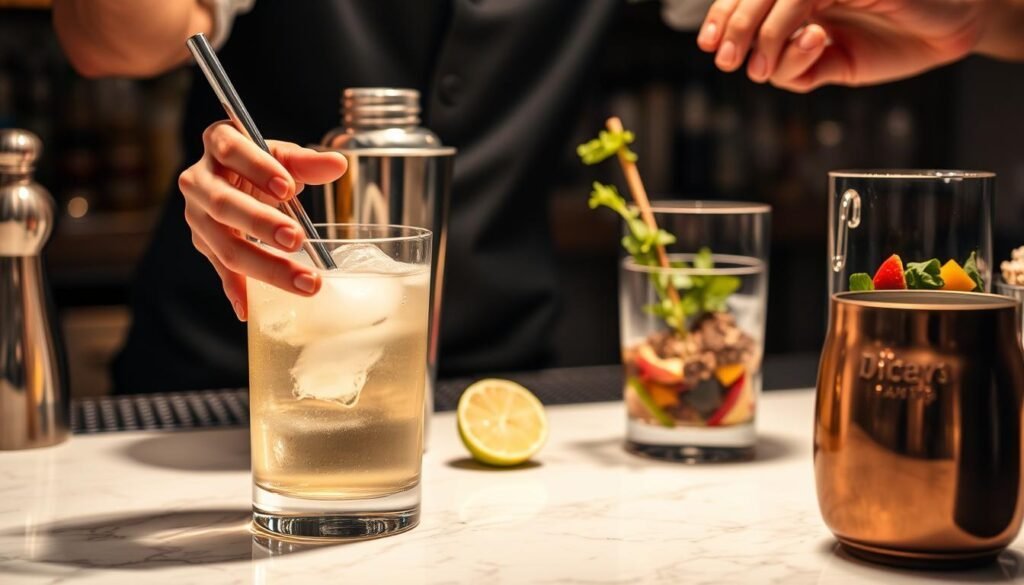
Muddling Tools and Their Proper Use
The right tool makes a big difference in muddling. A muddler is the most common tool, with a blunt end to press ingredients without tearing them. To use a muddler, gently press and twist for herbs, and press harder for harder ingredients. Using the right tool and technique ensures flavors are extracted well, making a balanced cocktail.
Practical Applications: Signature Cocktails by Technique
Mixology turns classic cocktails into something special. Bartenders use shaking, stirring, and muddling to make unique drinks. Let’s see how these methods are used in famous cocktails.
Classic Shaken Cocktails
Shaking is key in mixology. It makes some of the most loved cocktails refreshing and balanced.
Daiquiri, Margarita, and Whiskey Sour
The Daiquiri, Margarita, and Whiskey Sour are shaken to perfection. The Daiquiri mixes white rum, lime juice, and simple syrup. The Margarita blends tequila, lime juice, and triple sec. The Whiskey Sour uses whiskey, lemon juice, and simple syrup.
Adapting Recipes for Perfect Balance
Bartenders tweak ingredients to get the perfect mix. Adding more lime juice to a Daiquiri boosts its citrus. Using fresh ingredients and adjusting simple syrup makes a big difference.
Iconic Stirred Drinks
Stirring is an art that needs skill. Iconic stirred drinks are clear and smooth.
Manhattan, Negroni, and Old Fashioned
The Manhattan, Negroni, and Old Fashioned are stirred to perfection. The Manhattan is whiskey, vermouth, and bitters. The Negroni is gin, Campari, and sweet vermouth. The Old Fashioned is whiskey, sugar, and bitters.
Temperature and Dilution Control
When stirring, controlling temperature and dilution is key. The goal is to chill without diluting too much. The right glassware and stirring technique are essential for balance.
Muddled Masterpieces
Muddling releases flavors from fresh ingredients. Muddled masterpieces are complex and refreshing.
Mojito, Caipirinha, and Mint Julep
The Mojito, Caipirinha, and Mint Julep show muddling’s art. The Mojito is rum, lime juice, mint, and soda water. The Caipirinha is cachaça, lime juice, and sugar. The Mint Julep is bourbon, mint, and sugar.
Balancing Muddled Flavors
To balance muddled cocktails, bartenders adjust ingredients. For example, more lime juice in a Mojito boosts citrus.
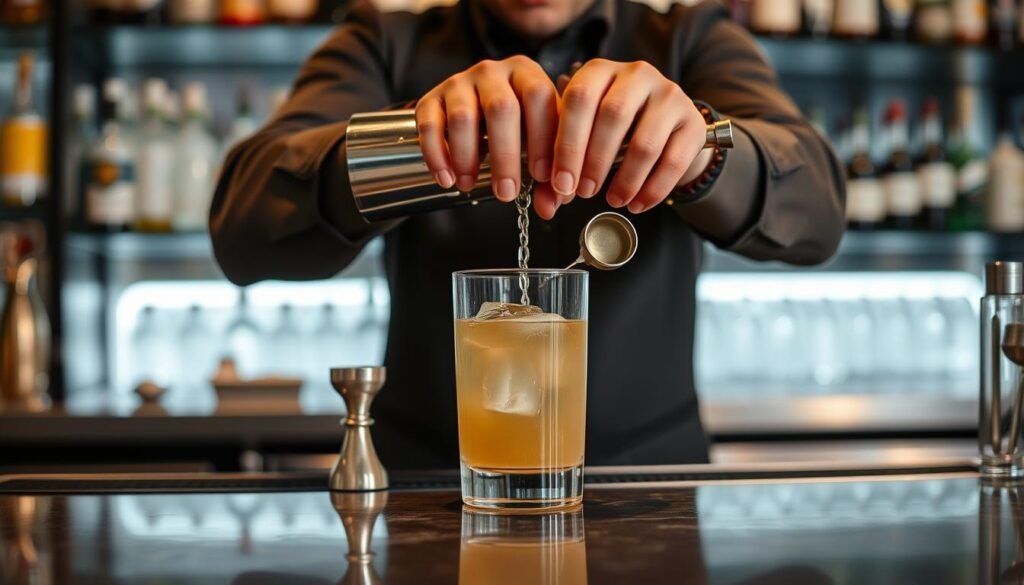
Conclusion: Elevating Your Drink Mixing Skills
Mastering mixology takes dedication and a love for trying new things. This Guide to Mixing Drinks has given you a good start. You now know the basics of shaking, stirring, and muddling.
To get even better, use the right tools and ingredients. Remember, practice makes perfect. Keep trying new recipes and flavors.
As you get better, you’ll learn to mix flavors and textures just right. With time and effort, you’ll make amazing cocktails. You’ll impress everyone with your skills.
FAQ
What is the difference between shaking and stirring a cocktail?
When should I muddle ingredients in a cocktail?
What are the essential tools needed for mixing drinks?
How do I achieve the perfect dilution and temperature when stirring a cocktail?
What are some common mistakes to avoid when shaking a cocktail?
Can I use a blender instead of a shaker to mix cocktails?
How do I choose the right type of shaker for my cocktails?
What is the best way to muddle mint leaves without bruising them?

From refreshing non-alcoholic sips to simple cocktails anyone can make, Ryan’s goal is to help you pour great drinks without the guesswork. Whether you’re hosting a party or just want something quick and tasty, Ryan’s practical tips make mixing drinks fun, fast, and stress-free.
Subscribe to Our Newsletter

